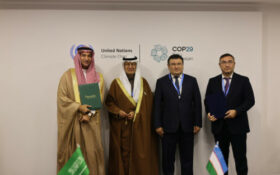
Providing power to remote sites for operating automated equipment or monitoring systems is often expensive or has major cost and carbon consumption implications.
UPS Systems has worked with England and Wales’ Environment Agency using the latest fuel cell technology to provide low emission, long runtime, standalone power for remote sites. Not only does this solve power supply issues in these remote areas but also helps meet carbon reduction commitments in minimising installation, maintenance and operational costs.
With technology becoming ever more reliant on being automated to keep costs down, it is not surprising that a supply of electrical power to equipment and monitoring systems is key to their operation.
This is even more important for the growing number of remote sites where current power supply options are either unavailable or uneconomical to install or maintain. In addition the use of traditional remote power options such as generators or batteries often requires regular visits to site to refuel or swap-out. This increases the amount of man hours and vehicle transport required, which in turn increases carbon consumption, noise and emissions outputs.
The requirement
The Eel Management Plan for the North West River Basin District (RBD) aims to describe the current status of eel population and assess compliance with targets. This will assist in the recovery of stocks of European eels. The River Mersey flows westward towards Liverpool and the Mersey Estuary and is part of the North West River Basin District.
The installation of an eel pass at Woolston Weir on the River Mersey and the monitoring of this and other obstructions to eel migration in the North West RBD is part of the programme of measures for the European Commission’s Water Framework Directive (WFD). Data from the monitoring will be translated into a regional Geographic Information System (GIS)-based eel prioritisation tool.
This project took place at the Environment Agency’s Warrington Fisheries site where long-term reliable power was needed to operate and monitor their newly installed eel flap-gate.
The fuel cell unit provides continuous power to a water pump, which oxygenates a holding tank where the elvers (juvenile eels) are counted and checked. The remote station also has a webcam and telemetry system powered by the fuel cell.
Fisheries scientists estimate that the population of elvers have decreased significantly by over 95% across Europe. Eels are still present in British waterways, but without initiatives such as these new flap gates, the long-term future of eels in the UK is a concern. The cause of this decline is unknown, but it is unlikely to be a single factor. Many wetlands that eels depend on to grow and mature have been lost, changed or access lost through installation of older-style flap gates in recent decades.
Normal types of flap gate represent a significant obstacle to eels as they navigate the river, preventing fish from entering important water courses for protection, reproduction and growth. The specially-designed flap gate installed in Warrington allows fish and eels to negotiate the structure more easily without increasing flood risk, as well as helping the Environment Agency meet WFD requirements and eel regulation obligations at the site.
The fuel cell solution
Although the mechanics of power generation are very different between traditional generators and fuel cells, they both have one thing in common – they produce electrical power. However, unlike an internal combustion engine being required to turn a generator, power from a fuel cell is direct and requires no combustion or mechanical form of generation.
The electrochemical reaction occurring in a fuel cell utilises the ionisation of a hydrogen-rich fuel across a semi-permeable membrane and its combination with oxygen to create pure water and electrical power. This ionisation of hydrogen and the electrochemical production of water provides a flow of free electrons between the anode and cathode of a fuel cell producing an electrical current.
As power is produced directly from the fuel cell, the system is considerably more efficient than an internal combustion generator, by up to 400% in many cases, creating associated fuel and cost savings.
The fuel cell system
The fuel cell used in the Warrington Fisheries project provided by UPS Systems is the EFOY 2200 Pro DMFC (direct methanol fuel cell) using liquid methanol as a fuel source. Due to the energy-density of methanol as a fuel, a relatively small volume provides an extremely long runtime for the eel gate and monitoring system.

The added advantage of being able to link two fuel canisters together using an automatic transfer switch, means that the fuel cell can be left for up to four months without the need to refuel. This reduces the number of site visits required compared to other power generation systems. The site telemetry which is also powered by the fuel cell is used to monitor equipment function and performance over extended periods.
The fuel cell units weigh only 12kg and are about the size of a small carry-on suitcase, making them easy to transport and install. The methanol fuel cartridges vary from 5 to 28 litres in volume so are also easily carried to site. The heaviest item of the system is the battery. The units can also be supplied in a weather and theft-proof enclosure for outdoor use.
The DMFC fuel cell generators used in this project operate in conjunction with two Elecsol 12V 110 Ah leisure batteries in parallel, which carry the power load of the gate and ancillary systems. The fully automated DMFC then effectively acts as a battery charger ensuring that the batteries are kept at optimum voltage at all times.
The intelligent DMFC system continuously monitors the battery voltage and as soon as the load has reduced the voltage to a pre-set figure (normally 12.2V) the system will automatically start, charge the batteries back to 14.4V before automatically shutting down again.
This intelligent charging pattern also maintains the batteries in peak condition, extending their operational lifetime. The continuous deep discharge cycling occurring in a standard battery replacement programme will cause premature ageing, which increases the battery replacement cost considerably over the life of a project.
Fuel life is also extended within the new fuel cell system as the unit is only running during charging. A traditional style generator would run continuously in this type of application.
Unlike standard generators the only mechanical parts within an EFOY DMFC are a small fuel pump and a cooling fan. Having so few moving parts results in higher levels of reliability and reduced noise levels which compare to those of a laptop PC. The need for maintenance visits to site is reduced as well as making the DMFC system ideal for use in environmentally ‘noise’ sensitive areas.

All methanol fuel supplied for the EFOY DMFC systems are provided in non-refillable, recyclable, leak and impact-tested containers approved to Germany’s TÜV (Technischer Überwachungsverein, Technical Monitoring Association) standards. All containers are also approved to International Air Transport Association (IATA) transport standards.
The waste from the DMFC system’ only consists of a small amount of CO2 and pure water. “As the methanol fuel is increasingly being produced from renewable power we can consider our remote monitoring stations as running on clean energy,” says Wesley Irving from the Environment Agency’s Evidence Directorate’s Innovation team. “This fits well with our environmental policies for carbon reduction,” he adds.
Fuel cells for the future
While most fuel cell developments in industry are based around vehicles, there are a number of tried and tested systems currently available for use in portable and stationary prime and standby power applications.
Compact portable units which can be used for prime power applications such as the Warrington eel pass installation are available in the range of 50 to 850 W with larger stationary units from 10 kW upwards using a variety of fuel types from pure hydrogen to reformed natural gas.
Fuel cells are very much a current and viable technology for many uses – particularly where a reliable long-term low-power need is identified such as those for remote monitoring and power applications.











